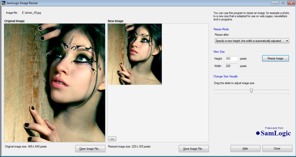|
 Which image format is best for email newsletters: JPEG, GIF or PNG?We can start with excluding file formats such as BMP, TIFF and EPS. They are neither suitable for web nor email. Many web browsers and email clients cannot even display them. The remaining image file formats, JPEG, GIF and PNG, are well adapted for the Internet, and below we provide you with a brief description about the differences between these three image file formats. n JPEG (JPG)  JPEG
(sometimes also written as JPG) is an acronym for Joint Photographic
Experts Group. It is an image file format optimized for photographs.
A JPEG image can contain up to 16.8 million colors so the number of
shades of one color is extremely large. That is why JPEG is so good at
handling photographs. JPEG has also a very efficient compression
technique that combines high compression degree with minimal quality
loss. However, there is a certain limit for JPEG's image compression,
and that is when the picture quality drop becomes visible. That can
happen if you use a very high compression degree. The reason to this is
that the JPEG compression method removes information from the image (so
called
lossy compression). If you compress the image a lot, the quality
loss becomes visible to the naked eye. JPEG
(sometimes also written as JPG) is an acronym for Joint Photographic
Experts Group. It is an image file format optimized for photographs.
A JPEG image can contain up to 16.8 million colors so the number of
shades of one color is extremely large. That is why JPEG is so good at
handling photographs. JPEG has also a very efficient compression
technique that combines high compression degree with minimal quality
loss. However, there is a certain limit for JPEG's image compression,
and that is when the picture quality drop becomes visible. That can
happen if you use a very high compression degree. The reason to this is
that the JPEG compression method removes information from the image (so
called
lossy compression). If you compress the image a lot, the quality
loss becomes visible to the naked eye.JPEG in general is very good at handling photographs, but it is much less successful at handling text, drawings (with straight lines) and similar. Text stored in JPEG may become slightly blurry and it is therefore not recommended to use JPEG for showing text. Instead, use the GIF or PNG format for this purpose. Below you can see how different the quality can be between JPEG and the two other image formats; GIF and PNG:
How blurry text stored in JPEG becomes, depends on the compression degree. The less you compress the picture, the sharper the text will get. However, this also means that the image file size remain bigger with less compression.
n GIF GIF is an acronym for Graphics Interchange Format. An image of the GIF format can contain up to 256 different colors. This means that GIF is not a good a choice for photographs as the number of available colors is very low. On the other hand, GIF provides a good option for handling text and illustrations. To begin with, less color tones enhance image contrast (with stronger image outlines). Another plus is that GIF compression technique does not remove any information from the image so the picture quality remains unchanged, even if the file size has been reduced. For images containing text, always consider choosing GIF format before JPEG. Alternatively, PNG format can be used as it also handles text very well and it is therefore suitable for saving images with text as well. Another advantage with GIF is that parts of the image can be made transparent. That is not possible with JPEG. A picture that is (partially) transparent can for instance be placed over another image with the effect that the image beneath is partially visible through the image. This can be useful for example when placing text or graphic objects over photographs or other images. A further advantage with GIF is that the format can be used to create animated images. This is fairly common on websites, and it is also sometimes used for email, although not all email clients support it. However, web-based email clients are usually able to display an animated GIF without problems.
n PNG PNG is an acronym for Portable Network Graphics. It is a newer image format compared to JPEG and GIF. PNG was partly designed to replace GIF and as such, it comes with new features. There are three types of PNG image format: PNG-8 which supports up to 256 colors, PNG-24 which can contain up to 16.8 million colors and PNG-32 that can handle up to 16.8 million colors and has an advanced functionality for transparency. PNG supports transparency just like GIF, meaning selected image areas (or whole images) can be made transparent. Additionally, PNG even allows you to specify the degree of transparency in percents (so called alpha compositing). That means that you can control to which grade the background image will be showing through. It also gives you the possibility to merge PNG images together with their background in a far better way compared to GIF. This can be best seen when circular or irregular shaped images are placed over other pictures. The transparency degree control also allows you to create realistic shadow effects by enabling interaction between foreground and background images in a way that is not possible with GIF. PNG is quite good at dealing with photographs as well. In fact, it is much better than GIF and generally as good as JPEG. PNG uses a different compression method than JPEG that does not cause any information or image quality loss (so called lossless compression). The downside of the PNG compression technique is that you cannot shrink the file size as much as with JPEG. This means that the image file size of large pictures can be quite big. If you need to significantly reduce the image file size, it is preferable to use the JPEG format for that. Additional PNG disadvantage is that some older web browsers and email clients do not support the format as it is quite new compared to GIF and JPEG. However, all new web browsers and email clients fully support the PNG file format.
What image format is the best? There is no obvious answer to this question as it all depends on the context. In general, the JPEG format is suitable for displaying photographs with minimal file size requirement. The GIF format is suitable when using text in images, for viewing illustrations, showing animated images and images with simple transparency. The PNG format is suitable when there is a need for more advanced transparency control and for handling logos and detailed colorful icons. More information  Read
also these informative articles on Litmus website to get more details
and facts: Read
also these informative articles on Litmus website to get more details
and facts:See also See also this article on our website that gives you information about where you can find free and cheap images:
Related products: SamLogic MultiMailer Image Resizer Other articles More articles are available from the article index page. |
|
||||||||||||||||||||||||||||||||||||||||||||||||||||||||||||||||||||||||||||||
| Article written by: Mika Larramo | Swedish |









 Converting
between different image formats
Converting
between different image formats